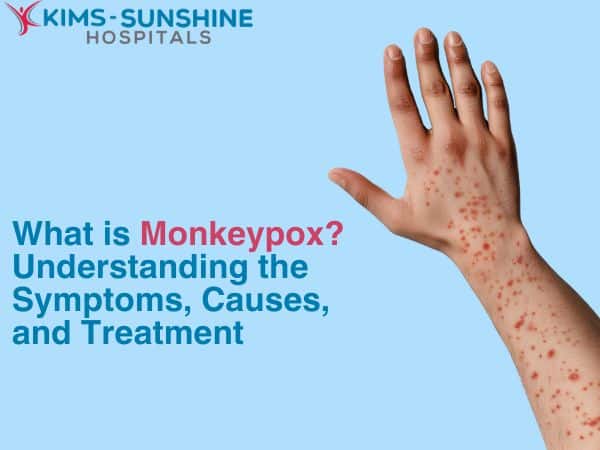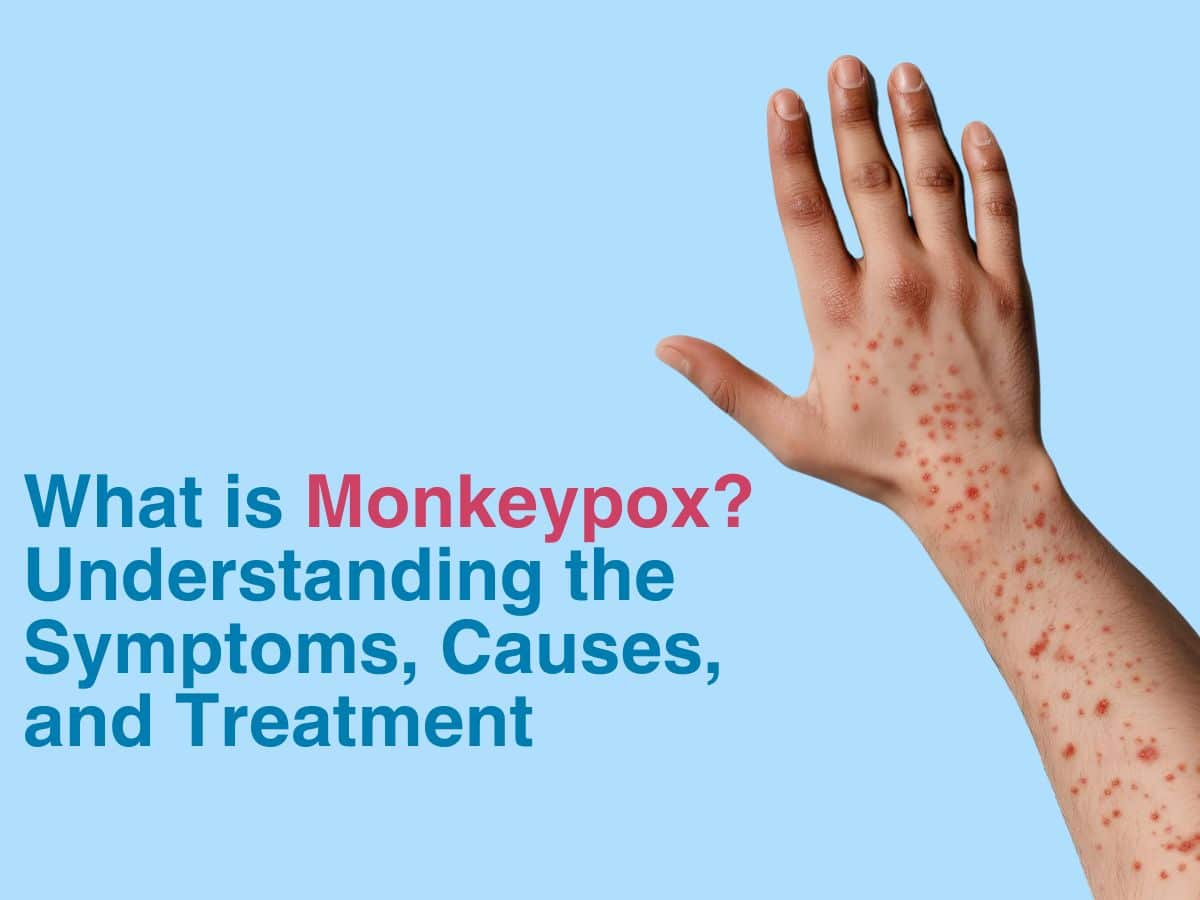
What is Monkeypox? Understanding the Symptoms, Causes, and Treatment

Monkeypox has recently gained attention due to outbreaks in various parts of the world. This blog post aims to provide a comprehensive overview of monkeypox, including its symptoms, causes, treatment, and prevention methods.
What is Monkeypox?
Monkeypox is a viral infection caused by the monkeypox virus, which belongs to the same family of viruses as smallpox. While generally less severe than smallpox, monkeypox can still cause significant health concerns and requires proper understanding and management.
Early Symptoms of Monkeypox
Recognizing the early symptoms of monkeypox is crucial for timely diagnosis and treatment. The initial signs typically appear 7-14 days after exposure and may include:
- Fever
- Headache
- Muscle aches
- Fatigue
- Swollen lymph nodes
These symptoms are often followed by a distinctive rash that usually starts on the face and spreads to other parts of the body.
How is Monkeypox Transmitted Between Humans?
Monkeypox can spread from person to person through:
- Close physical contact with an infected person, especially with their rash or bodily fluids
- Respiratory droplets during prolonged face-to-face contact
- Touching contaminated items like clothing or bedding
It’s important to note that monkeypox is not as easily transmitted as some other viral infections, such as the flu or COVID-19.
Monkeypox vs Smallpox: What’s the Difference?
While monkeypox and smallpox are caused by related viruses, there are several key differences:
- Severity: Monkeypox is generally less severe than smallpox.
- Lymph node swelling: This is common in monkeypox but rare in smallpox.
- Occurrence: Smallpox has been eradicated globally, while monkeypox still occurs in some regions.
- Mortality rate: Monkeypox has a lower mortality rate compared to smallpox.
Common Causes of Monkeypox Outbreaks
Monkeypox outbreaks can occur due to various factors:
- Zoonotic transmission from infected animals to humans
- Travel from endemic regions to non-endemic areas
- Close contact with infected individuals in healthcare or household settings
- Inadequate public health measures and surveillance
Best Treatments for Monkeypox Symptoms
While there’s no specific cure for monkeypox, several treatments can help manage symptoms and prevent complications:
- Antiviral medications (in severe cases)
- Pain relievers and fever reducers
- Proper hydration and nutrition
- Topical treatments for skin lesions
- Isolation to prevent spread
Can Monkeypox be Treated at Home?
In many cases, mild monkeypox infections can be managed at home under the guidance of healthcare professionals. Home care may involve:
- Isolating to prevent transmission
- Rest and hydration
- Over-the-counter pain relievers
- Keeping skin lesions clean and dry
- Avoiding scratching or touching the rash
However, it’s crucial to consult with a healthcare provider for proper diagnosis and treatment recommendations.
How Long Does it Take to Recover from Monkeypox?
The duration of a monkeypox infection typically ranges from 2 to 4 weeks. Most people recover without serious complications. The healing process involves:
- Gradual subsiding of fever and other flu-like symptoms
- Progression of the rash through various stages
- Scabbing and falling off of skin lesions
Full recovery occurs when all scabs have fallen off and a new layer of skin has formed.
How to Prevent Monkeypox Infection
Prevention is key in controlling the spread of monkeypox. Here are some essential preventive measures:
- Avoid close contact with infected individuals or animals
- Practice good hand hygiene
- Use personal protective equipment when caring for infected individuals
- Properly clean and disinfect contaminated surfaces
- Get vaccinated if you’re at high risk or as recommended by health authorities
Vaccines Available for Monkeypox Prevention
While there isn’t a specific monkeypox vaccine, the smallpox vaccine has shown to be effective in preventing monkeypox infections. Two vaccines are currently used:
- JYNNEOS (also known as Imvamune or Imvanex)
- ACAM2000
These vaccines are typically recommended for individuals at high risk of exposure or as part of outbreak control measures.
What to Do if You Suspect You Have Monkeypox
If you suspect you might have monkeypox:
- Isolate yourself immediately to prevent potential spread
- Contact your healthcare provider or local health department
- Describe your symptoms and any potential exposure
- Follow medical advice for testing and treatment
- Cooperate with contact tracing efforts if diagnosed
Remember, early detection and proper management are crucial in controlling monkeypox infections and preventing outbreaks.
Conclusion
By understanding the symptoms, causes, and treatment options for monkeypox, we can better protect ourselves and our communities from this viral infection. Stay informed, follow preventive measures, and seek medical attention if you suspect exposure or infection.
Frequently Asked Questions
What are the first signs of monkeypox?
The initial symptoms of monkeypox typically appear 7-14 days after exposure and include:
- Fever
- Headache
- Muscle aches
- Backache
- Swollen lymph nodes
- Chills
- Exhaustion
These symptoms are usually followed by a distinctive rash within 1-3 days. The rash often begins on the face and then spreads to other parts of the body, including hands, feet, and genitals.
How is monkeypox different from smallpox?
While monkeypox and smallpox are caused by related viruses, there are several key differences:
- Severity: Monkeypox is generally less severe and has a lower mortality rate than smallpox.
- Lymph node swelling: This is a common symptom in monkeypox but rare in smallpox.
- Origin: Monkeypox can infect a wider range of animals, while smallpox primarily affected humans.
- Occurrence: Smallpox has been eradicated globally, while monkeypox still occurs in some regions, particularly in Central and West Africa.
- Transmissibility: Monkeypox is less contagious than smallpox was.
How can monkeypox be transmitted from person to person?
Monkeypox can be transmitted between humans through:
- Close physical contact with an infected person, especially direct contact with their rash, scabs, or body fluids.
- Respiratory secretions during prolonged, face-to-face contact or intimate physical contact.
- Touching items (such as clothing or bedding) that have been contaminated with the virus from an infected person.
- From a pregnant person to their fetus through the placenta.
It’s important to note that a person with monkeypox is contagious from the onset of symptoms until all scabs have fallen off and a new layer of skin has formed.
What are the treatment options for monkeypox?
There is no specific cure for monkeypox, but several approaches can help manage the infection:
- Supportive care: This includes rest, hydration, and over-the-counter pain relievers to manage fever and discomfort.
- Antiviral medications: In severe cases, antivirals such as tecovirimat (TPOXX) may be used. These were developed for smallpox but can be effective against monkeypox.
- Vaccinia Immune Globulin (VIG): This may be used in severe cases, particularly for immunocompromised patients.
- Symptomatic treatment: This includes managing specific symptoms as they arise, such as using topical treatments for skin lesions.
- Isolation: Patients are typically isolated to prevent transmission to others until they are no longer contagious.
Is there a vaccine for monkeypox?
Yes, there are vaccines that can be used to prevent monkeypox:
- JYNNEOS (also known as Imvamune or Imvanex): This is a newer, non-replicating live vaccine approved for the prevention of monkeypox and smallpox. It’s administered in two doses, 28 days apart.
- ACAM2000: This is an older-generation smallpox vaccine that can also provide protection against monkeypox. However, it has more side effects and is not recommended for people with certain health conditions.
These vaccines can be used in two ways:
- Pre-exposure prophylaxis: For people at high risk of exposure, such as laboratory workers handling the virus or healthcare workers treating monkeypox patients.
- Post-exposure prophylaxis: Given to people who have been exposed to monkeypox, ideally within 4 days of exposure to prevent the disease or reduce its severity.
It’s important to note that while these vaccines are effective, they are not widely available to the general public and are typically reserved for high-risk individuals or for use in controlling outbreaks.

Dr. J. Raghunath Reddy
MBBS, MD (Pulmonary Medicine), FCCM (NIMS)
HOD & Sr. Consultant Pulmonologist, Critical Care & Sleep Medicine Specialist






